
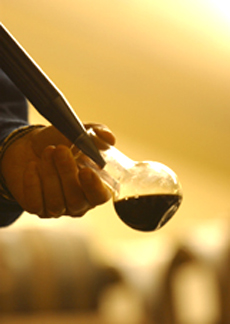
An inspector of the Consorzio examines the quality of a tradizionale balsamico: five experts judge each barrel before accepting or rejecting it. Photo courtesy of Academia Barilla.
May 2006
Updated December 2007
|
 |
Understanding Balsamic Vinegar,
Part I
Why Balsamic Vinegar of Modena, Italy Is The World’s Most Precious Vinegar
The sections highlighted in red are on this page. Click on the black links to go to other pages for the second and third parts of this article.
CAPSULE REPORT: Unlike any other vinegar, velvety, dark brown balsamic is both sweet and tart, a complex flavor profile. Its uniqueness comes from the fact that it is made from unfermented grape must instead of wine, and is aged in five different woods, the barrels of which are [ideally] at least half a century old. As it ages, the vinegar evolves from a fluid vinegar to a syrup-like consistency: A 50-year-old will resemble molasses in its color and thickness, and at that age has become a rare condiment, meted out with a medicine dropper to accent fine plates of food or great Parmigiano-Reggiano. There are five types of balsamic vinegars:
- Tradizionale and Condimento balsamics are made in Modena and Reggio-Emilia using artisan methods established in the Renaissance and dating back to the Middle Ages. Production of tradizionale is strictly monitored by a consortium. Condimentos are made using the same techniques but rare not submitted to the consortium for evaluation (there is a separate condimento consortium that does certify quality condimentos). These magnificent gourmet products are costly and costlier, and used to accent foods; tradizionales are also drunk like rare Ports. They are labeled Aceto Balsamico Tradizionale or Aceto Balsamico Condimento. To be assured of buying authentic balsamic vinegar, look for the seals of the tradizionale and condimento Consorzios. An authentic balsamic made in Modena will have the code API MO; one made in the Reggio Emilia province will have the code API RE.
- Industriale balsamics are mass-produced brands made in Italy. They use commercial processes, but still employ cooked grape must (the pressed juice of wine grapes that has not yet fermented) and are aged at least three years. Those that are made in the area of Modena and Reggio Emilia are labeled Aceto Balsamico di Modena. Use the AIB four-leaf ranking to guide your purchases.
- Imitation balsamics can be made anywhere and are generally cider vinegar that has been colored and flavored to approximate the real thing. They range in price and quality, and are best used for cooking and salad dressing.
- Other balsamics. Some U.S. producers of fine olive oil and vinegar are also making balsamics using artisanal methods. They don’t fall into tradizionale, condimento or industriale classifications, but they are good products.
Overview
Twenty-five years ago, balsamics were just getting known in the U.S.; tradizionales weren’t even available for purchase but had to be given as gifts from Italian friends. Today we are enriched with great products available at specialty stores and online; but sadly, most people have had only the imitation product, which is most of what is sold in the nation’s supermarkets. Given that balsamic vinegar is one of the great pleasures of the food world, seeking out an authentic bottle is well worth the time and expense. You have to learn how to read labels, ask, and then ask again. But, as with learning about wines, once you come up the curve a bit, the rewards are spectacular.
Gleaming dark brown in color with an intensely fruity aroma and an exquisite sweet-and-tart flavor, authentic aceto balsamico—balsamic vinegar—is a specialty of the Emilia-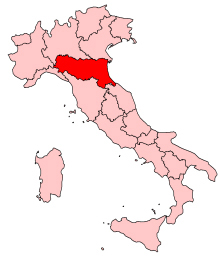 Romagna* region of northern Italy (map at right). It is made specifically in the provinces of Modena and Reggio Emilia and is often credited as originating in the city of Modena, but the truth may be lost to history. Today it is a protected with a D.O.P. designation—only vinegar made in the region can be called balsamic. Romagna* region of northern Italy (map at right). It is made specifically in the provinces of Modena and Reggio Emilia and is often credited as originating in the city of Modena, but the truth may be lost to history. Today it is a protected with a D.O.P. designation—only vinegar made in the region can be called balsamic.
*Midway between Milan and Florence, the capital of Emilia-Romagna is Bologna. Other important cities include Parma, Piacenza, Reggio Emilia, Modena, Rimini, Ferrara, Forlì, Cesena and Ravenna. The great D.O.P. cheese Parmigiano-Reggiano comes from the same region—it can only be made in the provinces of Parma and Reggio Emilia. Map courtesy of Wikipedia.org.
While sherry vinegar may be the queen, balsamic is truly the king of vinegars. No other vinegar improves with age and, at 75 years or older, can command more than $500 for a 3.5-ounce bottle. The true balsamic, called tradizionale, is as hard to find as a rare wine (and costlier on a per-ounce basis).
Sadly, most of the balsamic that is sold is imitation, so most people have never experienced the glories of the real thing.
The History of Balsamic Vinegar
Balsamic vinegar—or what is believed to be balsamic, as the written record is sparse—has been made since at least the 11th century. What is considered to be the first historical reference is in 1046: It is recorded that a well-known vinegar, laudatum acetum, produced in Canossa, a town in the province of Reggio Emilia, was given in a silver bottle as a present by the Marquis Bonifacio to the soon-to-be Holy Roman Emperor Enrico III of Franconia, when he passed through the area en route to Rome.
It is assumed, but can’t be verified, that the laudatum acetum was the same product we recognize as balsamic. It also was indicated in records that begin in the 1500s, via the writings of the poet Ludovico Ariosto (author of Orlando Furioso and native of Reggio Emilia) at the Estensi court. “Black vinegar” was mentioned as a mix of sour vinegar and saba (sweetened vinegar), with a typical bitter-sweet flavor.
In the 16th century, when the Estensi court moved to Modena, the first evidences of balsamic vinegar appear. Documents reveal it to have qualities that distinguish it from common vinegar and describe how to produce it, specifying that must from Trebbiano grapes must be left to mellow in an attic for several years. By the 1700s, it was recognized rare and valuable enough to be used as a special occasion vinegar and served to VIPs.
In its early days, balsamic vinegar was very available only to the nobility and the artisans who made it—themselves aristocrats. It was believed to be a miracle cure for everything from a sore throat to labor pains (the name balsamic, from balm, is derived from its purported medicinal properties, including its use as a protection against the plague). Made from local grapes and aged in local woods, for centuries it was made privately on individual estates and farmsteads, and only in the last few decades has become a commercial product, made for sale to others. Prior to then, balsamic was produced for family use only. Barrels passed from one generation to the next, often aging for 50 to 200 years or more. This “legacy” created an unimaginably rich, molasses-thick syrup served in droplets on Parmesan cheese and strawberries. Kept in locked cupboards and dispensed by the dropperful, from the beginning the precious black liquid was often part of a bride’s dowry—and it still is. Even the “youngsters,” just 12 or 25 years of age, are coveted.
We can revel in it—but where was balsamic vinegar during the generations of our parents and grandparents?
Unless yours were Italian, balsamic was not even on the radar screen. As a homemade product, it was not commercially available in the U.S. until the 1970s. At that time, several factors—the demand for fine foods from Europe based on Americans’ travels abroad, the turn of focus to the refined cuisine of northern Italy over the immigrant fare of the south, and the migration of great chefs to America—brought balsamic vinegar to the consciousness of fine chefs and gourmets and caused a burgeoning demand that led to commercial production of balsamic vinegar.
|
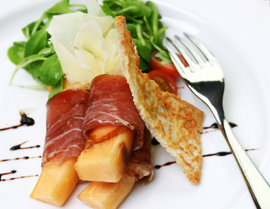
A beautiful first course: prosciutto, melon and shaved Parmesan, with a drizzle of 12-year-old condimento balsamic. It’s served here with focaccia
and a mâche and grape tomato salad, lightly dressed with olive oil and lemon juice. That’s Italian! |
By the 1980s, newspapers nationwide were publishing recipes for home cooks: Anyone could make chicken breasts with balsamic vinegar or glaze salmon with balsamic. Not the 100-year tradizionale, mind you, but with the commercial brands that had also become popular in Italy, and were being imported as well as replicated domestically.
The good stuff did arrive, too. By the 1990s, lovers of fine food had become aware that Parmigiano-Reggiano was not something to be grated over pasta, but perhaps the world’s greatest cheese, to be enjoyed with drops of rare balsamic vinegar; and that anything—even melon and prosciutto—could be accorded new excitement with a few drops of good balsamic.
But with the good came the bad. The surging popularity of balsamic brought unauthentic “authentic balsamics,” as well as an ocean of imitation balsamics—sugared and colored cheap vinegar masquerading as the real thing. To protect the reputation and value of authentic balsamic vinegar, in 1979 a marketing and exportation consortium was formed in Modena led by Ferdinando Cavalli, a local producer. The name “Aceto Balsamico Tradizionale di Modena” has been protected since 1983.
Next, visit Part II of this article and learn about the arduous process of creating artisan balsamic vinegar, the consorzios (consortiums) that strictly supervise authentic balsamic vinegar, rejecting batches that aren’t good enough and ensuring that when you buy a product with the official seal, it’s worth the money you pay. |
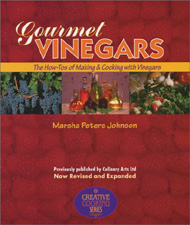 |
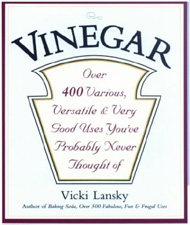 |
 |
| Gourmet Vinegars: The How-To’s of Making and Cooking with Vinegars, by Marsha Peters Johnson. Easy instructions to create delicate vinegars. Versatile recipes will encourage cooks to make vinegars a pantry staple. Click here for more information. |
Vinegar, by Vicky Lanksy. This comprehensive guide covers all types and uses of vinegar. Learn how to use vinegar varieties in the kitchen and beyond. A comprehensive index will help you become a true vinegar expert. Click here for more information. |
Zingerman’s Guide to Good Eating, by Ari Weinzweig. The famed Ann Arbor specialty food store owner demystifies vinegar, plus cheese, pasta, chocolate, and other specialty foods. Click here for more information. |
Lifestyle Direct, Inc. All rights reserved. Images are the copyright of their individual owners.

|
|





 Romagna* region of northern Italy (map at right). It is made specifically in the provinces of Modena and Reggio Emilia and is often credited as originating in the city of Modena, but the truth may be lost to history. Today it is a protected with a D.O.P. designation—only vinegar made in the region can be called balsamic.
Romagna* region of northern Italy (map at right). It is made specifically in the provinces of Modena and Reggio Emilia and is often credited as originating in the city of Modena, but the truth may be lost to history. Today it is a protected with a D.O.P. designation—only vinegar made in the region can be called balsamic. 


